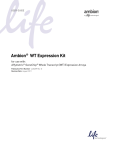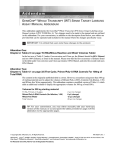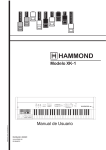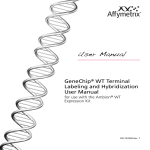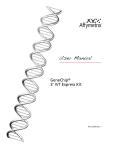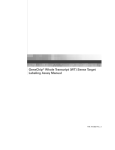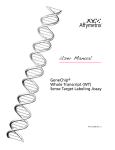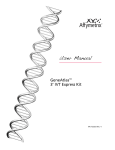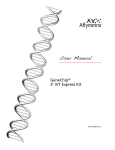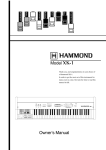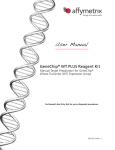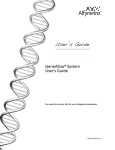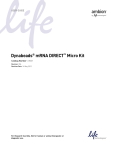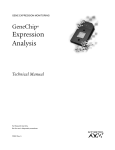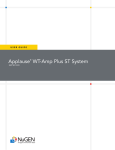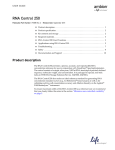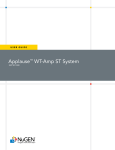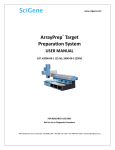Download Manual, GeneAtlasŁ WT Expression Kit, User Manual
Transcript
User Manual GeneAtlas™ WT Expression Kit User Manual P/N 702935 Rev. 3 For research use only. Not for use in diagnostic procedures. Trademarks Affymetrix®, Axiom™, Command Console®, DMET™, GeneAtlas™, GeneChip®, GeneChip-compatible™, GeneTitan®, Genotyping Console™, myDesign™, NetAffx®, OncoScan™, Powered by Affymetrix™, Procarta®, and QuantiGene® are trademarks or registered trademarks of Affymetrix, Inc. All other trademarks are the property of their respective owners. Limited License Subject to the Affymetrix terms and conditions that govern your use of Affymetrix products, Affymetrix grants you a nonexclusive, non-transferable, non-sublicensable license to use this Affymetrix product only in accordance with the manual and written instructions provided by Affymetrix. You understand and agree that except as expressly set forth in the Affymetrix terms and conditions, that no right or license to any patent or other intellectual property owned or licensable by Affymetrix is conveyed or implied by this Affymetrix product. In particular, no right or license is conveyed or implied to use this Affymetrix product in combination with a product not provided, licensed or specifically recommended by Affymetrix for such use. Patents Arrays: Products may be covered by one or more of the following patents: U.S. Patent Nos. 5,445,934; 5,744,305; 6,399,365; 6,733,977; 7,790,389 and other U.S. or foreign patents. Products are manufactured and sold under license from OGT under 5,700,637 and 6,054,270. Scanner: Products may be covered by one or more of the following patents: U.S. Patent Nos. 6,141,096, 6,262,838; 6,294,327; 6,403,320; 6,407,858; 6,597,000; 7,406,391; 7,682,782 and other U.S. or foreign patents. Software: Products may be protected by one or more of the following patents: U.S. Patent Nos. 6,090,555; 6,611,767; 6,687,692; 6,829,376; 7,130,458; 7,451,047; 7,634,363; 7,674,587 and other U.S. or foreign patents. Copyright © Affymetrix Inc. All rights reserved. Contents Chapter 1 Overview . . . . . . . . . . . . . . . . . . . . . . . . . . . . . . . . . . . . . . . . . . . . . . . . . . . . . 5 Control RNA . . . . . . . . . . . . . . . . . . . . . . . . . . . . . . . . . . . . . . . . . . . . . . . . . . . . . . . . . . . . .5 Whole Transcript Sense Target Labeling Assay Schematic . . . . . . . . . . . . . . . . . . . . . . . . . . .6 Assay Overview/Suggested Workflow . . . . . . . . . . . . . . . . . . . . . . . . . . . . . . . . . . . . . . . . . .7 Important Parameters for Successful Amplification . . . . . . . . . . . . . . . . . . . . . . . . . . . . . . . .7 Other Important Parameters . . . . . . . . . . . . . . . . . . . . . . . . . . . . . . . . . . . . . . . . . . . . . . .9 Kit Contents and Storage Conditions . . . . . . . . . . . . . . . . . . . . . . . . . . . . . . . . . . . . . . . . .10 Materials . . . . . . . . . . . . . . . . . . . . . . . . . . . . . . . . . . . . . . . . . . . . . . . . . . . . . . . . . . . . . .12 Necessary Reagents . . . . . . . . . . . . . . . . . . . . . . . . . . . . . . . . . . . . . . . . . . . . . . . . . . . . .12 Instruments . . . . . . . . . . . . . . . . . . . . . . . . . . . . . . . . . . . . . . . . . . . . . . . . . . . . . . . . . . .13 Lab Equipment and Supplies . . . . . . . . . . . . . . . . . . . . . . . . . . . . . . . . . . . . . . . . . . . . . .14 Safety Information . . . . . . . . . . . . . . . . . . . . . . . . . . . . . . . . . . . . . . . . . . . . . . . . . . . . . . .14 Chapter 2 cRNA Transcription Protocol . . . . . . . . . . . . . . . . . . . . . . . . . . . . . . . . . . . . . 15 Equipment and Reagent Preparation . . . . . . . . . . . . . . . . . . . . . . . . . . . . . . . . . . . . . . . . . .15 Prepare cRNA Wash Solution . . . . . . . . . . . . . . . . . . . . . . . . . . . . . . . . . . . . . . . . . . . . . .15 Program the Thermal Cycler . . . . . . . . . . . . . . . . . . . . . . . . . . . . . . . . . . . . . . . . . . . . . .15 Prepare Poly-A RNA Controls . . . . . . . . . . . . . . . . . . . . . . . . . . . . . . . . . . . . . . . . . . . . . .16 Reverse Transcription to Synthesize First-Strand cDNA . . . . . . . . . . . . . . . . . . . . . . . . . . . . .18 Second-Strand cDNA Synthesis . . . . . . . . . . . . . . . . . . . . . . . . . . . . . . . . . . . . . . . . . . . . . .19 In Vitro Transcription to Synthesize Labeled cRNA . . . . . . . . . . . . . . . . . . . . . . . . . . . . . . . .20 cRNA Purification . . . . . . . . . . . . . . . . . . . . . . . . . . . . . . . . . . . . . . . . . . . . . . . . . . . . . . . .21 Determine cRNA Yield . . . . . . . . . . . . . . . . . . . . . . . . . . . . . . . . . . . . . . . . . . . . . . . . . . . .24 cRNA Yield . . . . . . . . . . . . . . . . . . . . . . . . . . . . . . . . . . . . . . . . . . . . . . . . . . . . . . . . . . .24 cRNA Size Distribution (Optional) . . . . . . . . . . . . . . . . . . . . . . . . . . . . . . . . . . . . . . . . . .24 Chapter 3 cDNA Synthesis Protocol . . . . . . . . . . . . . . . . . . . . . . . . . . . . . . . . . . . . . . . . 25 Synthesize Second-cycle cDNA . . . . . . . . . . . . . . . . . . . . . . . . . . . . . . . . . . . . . . . . . . . . . .25 Hydrolyze Using RNase H . . . . . . . . . . . . . . . . . . . . . . . . . . . . . . . . . . . . . . . . . . . . . . . . . .27 Purify Second-cycle cDNA . . . . . . . . . . . . . . . . . . . . . . . . . . . . . . . . . . . . . . . . . . . . . . . . . .28 Assess Second Cycle cDNA Yield and Size Distribution . . . . . . . . . . . . . . . . . . . . . . . . . . . .30 Expected cDNA Yield . . . . . . . . . . . . . . . . . . . . . . . . . . . . . . . . . . . . . . . . . . . . . . . . . . . .30 (Optional) Expected cDNA Size Distribution . . . . . . . . . . . . . . . . . . . . . . . . . . . . . . . . . . .30 Fragmentation of Second Cycle cDNA . . . . . . . . . . . . . . . . . . . . . . . . . . . . . . . . . . . . . . . . .31 Labeling of Fragmented Single-Stranded DNA . . . . . . . . . . . . . . . . . . . . . . . . . . . . . . . . . . .33 Contents Chapter 4 4 Hybridization . . . . . . . . . . . . . . . . . . . . . . . . . . . . . . . . . . . . . . . . . . . . . . . . . 34 Target Hybridization Setup for Affymetrix® Array Strips . . . . . . . . . . . . . . . . . . . . . . . . . . . .34 GeneAtlas™ Software Setup . . . . . . . . . . . . . . . . . . . . . . . . . . . . . . . . . . . . . . . . . . . . . . . .39 Sample Registration . . . . . . . . . . . . . . . . . . . . . . . . . . . . . . . . . . . . . . . . . . . . . . . . . . . .39 Hybridization Software Setup . . . . . . . . . . . . . . . . . . . . . . . . . . . . . . . . . . . . . . . . . . . . .41 Appendix A Troubleshooting . . . . . . . . . . . . . . . . . . . . . . . . . . . . . . . . . . . . . . . . . . . . . . 44 Positive Control Reaction . . . . . . . . . . . . . . . . . . . . . . . . . . . . . . . . . . . . . . . . . . . . . . . . . .44 Control RNA Amplification Instructions . . . . . . . . . . . . . . . . . . . . . . . . . . . . . . . . . . . . . .44 Expected Results . . . . . . . . . . . . . . . . . . . . . . . . . . . . . . . . . . . . . . . . . . . . . . . . . . . . . . .44 Factors that Affect Both Positive Control and Experimental Samples . . . . . . . . . . . . . . . . . .44 Incubation Temperature(s) Were Incorrect . . . . . . . . . . . . . . . . . . . . . . . . . . . . . . . . . . . .44 Condensation formed in the tube during the reaction incubation(s) . . . . . . . . . . . . . . . .44 Nuclease Contamination . . . . . . . . . . . . . . . . . . . . . . . . . . . . . . . . . . . . . . . . . . . . . . . . .44 cRNA Purification Yield . . . . . . . . . . . . . . . . . . . . . . . . . . . . . . . . . . . . . . . . . . . . . . . . . .44 Troubleshooting Low Yield and Small Average cRNA Size . . . . . . . . . . . . . . . . . . . . . . . . . .45 Lower Than Expected Input RNA Concentration . . . . . . . . . . . . . . . . . . . . . . . . . . . . . . .45 Impure RNA Samples . . . . . . . . . . . . . . . . . . . . . . . . . . . . . . . . . . . . . . . . . . . . . . . . . . . .45 RNA Integrity is Compromised . . . . . . . . . . . . . . . . . . . . . . . . . . . . . . . . . . . . . . . . . . . . .45 The mRNA Content of Your total RNA Sample is Lower Than Expected . . . . . . . . . . . . . .45 Appendix B cRNA Purification Photos . . . . . . . . . . . . . . . . . . . . . . . . . . . . . . . . . . . . . . . 48 Appendix C Shaker Speeds . . . . . . . . . . . . . . . . . . . . . . . . . . . . . . . . . . . . . . . . . . . . . . . . 50 Appendix D FAQ . . . . . . . . . . . . . . . . . . . . . . . . . . . . . . . . . . . . . . . . . . . . . . . . . . . . . . . . . 51 WT Terminal Labeling Assay . . . . . . . . . . . . . . . . . . . . . . . . . . . . . . . . . . . . . . . . . . . . . . . .51 Appendix E Gel-Shift Assay . . . . . . . . . . . . . . . . . . . . . . . . . . . . . . . . . . . . . . . . . . . . . . . . 52 Appendix F Prepare the Control RNA. . . . . . . . . . . . . . . . . . . . . . . . . . . . . . . . . . . . . . . . 54 1 Overview The GeneAtlas™ WT Expression Kit Assay uses the Ambion® WT Expression Kit in conjunction with the GeneChip® WT Terminal Labeling Kit to generate amplified and biotinylated sense-strand DNA targets from the entire expressed genome without bias. The assay and the associated reagents are for use with Affymetrix® Gene 1.1 ST Array Strips, where “ST” stands for “Sense Target”. The probes on these arrays have been selected to be distributed throughout the entire length of each transcript. NOTE: The GeneAtlas WT Expression Kit Assay is not compatible with Affymetrix array strips designed to focus on the 3’ ends of transcripts. For the 3’ arrays, please use the GeneAtlas 3’ IVT Express Kit (visit www.affymetrix.com for more information). The Ambion WT Expression Kit enables you to prepare RNA samples for Affymetrix whole transcriptome (WT) analysis. The kit generates sense-strand cDNA from total RNA for subsequent fragmentation and labeling using the GeneChip® WT Terminal Labeling Kit. It is optimized for use with Affymetrix Gene 1.1 ST Array Strips. The Ambion WT Expression Kit represents the latest innovation in RNA amplification that enables faster, more sensitive, and highly reproducible results with Affymetrix® whole transcriptome microarrays and array plates. This kit features: A streamlined workflow that requires as little as 50 ng of total RNA for a single round of amplification Direct amplification of total RNA without a separate rRNA depletion step A novel priming method that selectively reverse transcribes non-ribosomal RNA for complete and unbiased coverage of the transcriptome Magnetic-bead cRNA and cDNA purification for high recovery and ease of use Pre-formulated master mixes that significantly reduce hands-on time The kit is based on a novel reverse transcription (RT) priming method that eliminates the need for a separate rRNA depletion step. The kit includes RT primers designed with a proprietary oligonucleotide matching algorithm that eliminates primer sequences with homology to known ribosomal RNA sequences. The result is complete and unbiased coverage of the transcriptome, with a significant reduction in rRNA amplification, compared to other methods. Target preparation for the The GeneAtlas WT Expression Kit Assay for array strips includes six steps in (Figure 1.1). At the end of target preparation, the denatured sample is ready to be fragmented, labeled and hybridized onto an Affymetrix ST Array Strip. Control RNA Use the included Control RNA to familiarize yourself with the GeneAtlas WT Expression Kit protocol. Instructions for preparing the control RNA are provided in Appendix F, Prepare the Control RNA on page 54. Chapter 1 | Overview Whole Transcript Sense Target Labeling Assay Schematic Figure 1.1 Assay Schematic For Generating Whole Transcript Sense Target ~1.25 hours .75 - 1 hour .75 - 1 hour 6 Chapter 1 | Overview 7 Assay Overview/Suggested Workflow1 Day 1 Synthesize first-strand cDNA Synthesize second-strand cDNA Synthesize cRNA using in vitro transcription Day 2 Purify cRNA Assess cRNA yield and size distribution Synthesize 2nd-cycle cDNA Hydrolyze using RNaseH Purify 2nd-cycle cDNA Assess cDNA yield and size distribution Fragment and label the single-stranded cDNA Start Hybridization – 20 hours – Start on Day 2, finish on Day 3 Day 3 Array Strip Washing, Staining, and Imaging – 2 hours. Important Parameters for Successful Amplification Input RNA Quantity and IVT Reaction Incubation Time Consider both the type and amount of sample RNA available and the amount of cDNA needed for your analysis when planning experiments using the GeneAtlas™ WT Expression Kit. Because mRNA content varies significantly with tissue type, the optimal amount of total RNA input should be determined empirically for each experimental system. The recommended input RNA amounts listed in Table 1.1 are based on using total RNA from HeLa cells; use these recommendations as a starting point. IMPORTANT: Optimal RNA input amount are sample-type dependent and should be determined empirically. It is recommended to keep input amount consistent within a given experiment. Table 1.1 Input RNA Limits Recommendations Amount Recommended 100 ng Minimum 50 ng Maximum 500 ng NOTE: The RNA needs to be diluted to an appropriate concentration such that the desired input amount is present in a 3 μL volume. For example, for 100 ng input, RNA concentration should be 33.3 ng/μL. Figure 1.2 on page 8 shows the cRNA yields with varying inputs of three RNAs: the HeLa Kit control, Stratagene® Universal Human Reference RNA (UHRR), and Ambion FirstChoice® Human Brain Reference RNA (HBRR). For each RNA, the plot displays the yields from eight titration points: 0 ng, 12.5 ng, 25 ng, 50 ng, 100 ng, 200 ng, 400 ng, and 800 ng. 1 Assumes that only one sample is carried through the assay. The estimated time required may be longer if multiple samples are processed simultaneously. Chapter 1 | Overview 8 Figure 1.2 cRNA yields with varying inputs of three RNAs RNA Purity RNA quality is the single most important factor affecting how efficiently an RNA sample will be amplified. RNA samples should be free of contaminating proteins, DNA, and other cellular material as well as phenol, ethanol, and salts associated with RNA isolation procedures. Impurities can lower the efficiency of reverse transcription and subsequently reduce the level of amplification. An effective measure of RNA purity is the ratio of absorbance readings at 260 and 280 nm. The ratio of A260 to A280 values should fall in the range of 1.7–2.1. RNA must be suspended in high quality water, TE (10 mM Tris-HCl, 1 mM EDTA). RNA Integrity The integrity of the RNA sample, or the proportion that is full length, is another important component of RNA quality. Reverse transcribing partially degraded mRNAs will generate cDNAs that may lack portions of the transcripts that are interrogated by probes on the array. RNA integrity can be evaluated by microfluidic analysis using the Agilent 2100 bioanalyzer with an RNA LabChip® Kit. Primarily fulllength RNA will exhibit a ratio of 28S to 18S rRNA bands that approaches 2:1. Using a bioanalyzer, the RIN (RNA Integrity Number) can be calculated to further evaluate RNA integrity. The RIN, a metric developed by Agilent, includes information from both the rRNA bands and outside the rRNA peaks (potential degradation products) to provide a picture of RNA degradation states. Search for “RIN” at the following web site for further information: www.chem.agilent.com. Figure 1.3 Example Agilent Bioanalyzer Electropherograms from three different total RNAs of varying integrity. Panel [A] represents a highly intact total RNA (RIN = 9.2), panel [B] represents a moderately intact total RNA (RIN = 6.2), and panel [C] represents a degraded total RNA sample (RIN = 3.2). Chapter 1 | Overview 9 NOTE: Total RNAs with lower RIN values may require increased input amounts to generate enough cDNA for hybridization to an array. Denaturing agarose gel electrophoresis and nucleic acid staining can also be used to separate and visualize the major rRNA species. After purification, RNA concentration is determined by absorbance at 260 nm on a spectrophotometer (1 absorbance unit = 40 μg/mL RNA). The A260/A280 ratio should be approximately 2.0, with ranges between 1.8 to 2.1 considered acceptable. We recommend checking the quality of RNA by running it on an agarose gel prior to starting the assay. When the RNA resolves into discrete rRNA bands (i.e., no significant smearing below each band), with the 28S rRNA band appearing approximately twice as intense as the 18S rRNA band, then the mRNA in the sample is likely to be mostly full-length. The primary drawback to gel electrophoresis is that it requires microgram amounts of RNA. Other Important Parameters Keep reaction incubation times precise and consistent: The incubation times for the enzymatic reactions in the protocol were optimized in conjunction with the kit reagents for maximum yield in each step—adhere to them closely. Use master mixes: We strongly recommend preparing master mixes for each step of the procedure. This reduces the effects of pipetting error, saves time, and improves reproducibility. The fill volumes in the kit allow for a ~10% overage when making master mixes. Mix each kit component before use: Mix enzyme solutions by gently flicking the tube a few times before adding them to master mixes. Thaw frozen reagents completely at room temperature, then mix thoroughly by vortexing, and place on ice. Incubate reactions in a calibrated thermal cycler: We do not recommend using ordinary laboratory heat blocks, water baths, or hybridization ovens for any of the reaction incubations. The procedure is very sensitive to temperature; therefore use a thermal cycler that has been calibrated according to the manufacturer’s recommended schedule. Variable or inaccurate incubation temperatures can negatively impact yield. Heated lids: It is important that condensation does not form in the tubes during any of the incubations, because it would change the reaction composition and can greatly reduce yield. If possible, set the lid temperature to match the block temperature. Otherwise, incubate all reactions with the heated lid on (~100°C). Maintain procedural consistency: Procedural consistency is very important for amplification experiments. Consider implementing a detailed procedural plan that will be used by everyone in the lab to maintain consistency. This type of plan will minimize variation due to subtle procedural differences can complicate gene expression studies. The plan should include basic information such as the method of RNA isolation, the amount of RNA to use in the procedure, and how long to incubate the reaction. It should also address specifics that are not often included in protocols such as which tubes and thermal cycler to use for each step in the process. Finally, develop a consistent work flow. For example standardize stopping points in the method. The idea is to standardize all of the variables discussed in this section of the manual and carefully follow all the protocol steps in order to maximize consistency among samples. Use Poly-A RNA Controls to monitor the target labeling process: The use of Poly-A RNA Controls allows you to evaluate assay sensitivity, consistency, and dynamic range. The kit contains four exogenous, pre-mixed, poly-adenylated prokaryotic controls that are spiked directly into RNA samples before target labeling. Their resultant signal intensities on Affymetrix® brand array strips serve as sensitive indicators of the labeling reaction efficiency, independent from starting sample quality. Chapter 1 | Overview 10 Kit Contents and Storage Conditions Table 1.2 Ambion WT Expression Kit Component Vol/Qnty 10 Rxn Kit Vol/Qnty 30 Rxn Kit Storage First-Strand Enzyme Mix 11 μL 33 μL –20°C First-Strand Buffer Mix 44 μL 132 μL –20°C Second-Strand Enzyme Mix 55 μL 165 μL –20°C Second-Strand Buffer Mix 138 μL 413 μL –20°C IVT Enzyme Mix 66 μL 198 μL –20°C IVT Buffer Mix 264 μL 792 μL –20°C Control RNA (1 mg/mL HeLa total RNA) 10 μL 10 μL –20°C Nuclease-free Water 1.75 mL 1.75 mL any temp* 2nd-Cycle Buffer Mix 88 μL 264 μL –20°C Random Primers 22 μL 66 μL –20°C 2nd-Cycle Enzyme Mix 88 μL 264 μL –20°C RNase H 22 μL 66 μL –20°C Nucleic Acid Binding Buffer Concentrate 1.1 mL 3.3 mL room temperature Nucleic Acid Binding Beads 220 μL 660 μL 4°C† Nucleic Acid Wash Solution Concentrate 10 mL 20 mL room temperature Elution Solution 5 mL 5 mL 4°C or room temp Nuclease-free Water 10 mL 10 mL room temperature 8-Strip PCR Tubes & Caps (0.2 mL) 10 40 room temperature U-Bottom Plate 2 4 room temperature Reservoir 1 2 room temperature Nucleic Acid Purification Reagents Consumables * Store † Do the Nuclease-free Water at –20°C, 4°C, or room temp. not freeze. Chapter 1 | Overview Table 1.3 GeneChip® WT Terminal Labeling Kit Component Vol 10 Rxn Kit Vol 30 Rxn Kit Storage 10X cDNA Fragmentation Buffer 48 μL 144 μL –20°C UDG, 10U/μL 10 μL 30 μL –20°C APE 1, 1000U/μL 10 μL 30 μL –20°C TdT, 30U/μL 20 μL 60 μL –20°C 5X TdT Buffer 120 μL 360 μL –20°C DNA Labeling Reagent, 5mM 10 μL 30 μL –20°C RNase-free Water 825 μL 2 x 825 μL –20°C Table 1.4 GeneAtlas™ Hybridization, Wash, and Stain Kit for WT Array Strips (P/N 901667) Component Volume Storage GeneAtlas Hybridization Module for WT Array Strips (P/N 901668) 5X WT Hyb Add 1 (P/N 901618) 3 x 925 μL 2°C to 8°C 15X WT Hyb Add 4 (P/N 901619) 3 x 355 μL 2°C to 8°C 2.5X WT Hyb Add 6 (P/N 901620) 3 x 1,525 μL 2°C to 8°C Stain Cocktail 1 (P/N 901541) 52.5 mL 2°C to 8°C Stain Cocktail 2 (P/N 901542) 26.3 mL 2°C to 8°C 15 mL 2°C to 8°C Wash Buffer A 519 mL 2°C to 8°C Wash Buffer B 64 mL 2°C to 8°C Array Holding Buffer (P/N 901543) GeneAtlas Wash Buffers (P/N 901625) 11 Chapter 1 | Overview 12 Materials Necessary Reagents Table 1.5 Necessary Reagents Material Source P/N Ambion 4411973 (30 Rxn) or 4411974 (10 Rxn) Affymetrix 901524 (30 Rxn) or 901525 (10 Rxn) GeneChip® Poly-A RNA Control Kit Contains: Poly-A Control Stock Poly-A Control Dil Buffer Affymetrix 900433 (100 Rxn) GeneChip® Hybridization Control Kit Contains: 20X Hybridization Controls 3 nM Control Oligo B2 Affymetrix 900454 (30 Rxn) or 900457 (150 Rxn) Affymetrix 900671 (30 Rxn) or 900670 (10 Rxn) GeneAtlas™ Hybridization, Wash, and Stain Kit for WT Array Strips See Table 1.4 for detailed kit information Affymetrix 901667 (60 Rxn) 100% Ethanol (ACS grade or equivalent) multiple 100% Isopropanol (ACS grade or equivalent) multiple (Optional) Quant-iT™ RiboGreen® RNA Reagent Invitrogen (Optional) Quant-iT™ PicoGreen® RNA Reagent Invitrogen RNA 6000 Nano Kit Agilent Technologies 5067-1511 (Optional) RNaseZap® RNase Decontamination Solution Ambion AM9780 (250 mL) AM9784 (4.0 L) (Optional) The RNA Storage Solution Ambion AM7000 (10×1.0 mL) AM7001 (50 mL) Target Preparation Assay Ambion® WT Expression Kit See Table 1.2 for detailed kit information Controls, Fragmentation and Labeling GeneChip® WT Terminal Labeling Kit and Controls Kit* Contains: ® GeneChip WT Terminal Labeling Kit ® GeneChip Poly-A RNA Control Kit ® GeneChip Hybridization Control Kit Controls Fragmentation and Labeling GeneChip® WT Terminal Labeling Kit See Table 1.3 for detailed kit information Hybridization, Stain and Wash *Controls and terminal labeling kits may be ordered separately. Chapter 1 | Overview Table 1.5 (Continued) Necessary Reagents Material Source P/N Novex XCell SureLock Mini-Cell† Invitrogen EI0001 TBE Gel, 4-20%,1.0 mm, 12 well Invitrogen EC62252 Novex Hi-Density TBE Sample Buffer (5X) Invitrogen LC6678 TBE Buffer, 5x Solution USB 75891 SYBR Gold Invitrogen S-11494 10 bp DNA ladder and 100 bp DNA ladder Invitrogen 10821-015 15628-019 ImmunoPure NeutrAvidin Pierce 31000 PBS, pH 7.2 Invitrogen 20012-027 Gel-Shift Assay (Optional) * Controls † Or and terminal labeling kits may be ordered separately. equivalent. Instruments Table 1.6 Instruments Instruments Manufacturer P/N GeneAtlas™ Fluidics Station Affymetrix 00-0377 GeneAtlas™ Imaging Station Affymetrix 00-0376 GeneAtlas™ Hybridization Station Affymetrix 00-0380 (115VAC) 00-0381 (230VAC) GeneAtlas™ Workstation Affymetrix 90-0894 GeneAtlas™ Barcode Scanner Affymetrix 00-0379 13 Chapter 1 | Overview 14 Lab Equipment and Supplies Table 1.7 Lab Equipment and Supplies Material Source P/N Lab Equipment and Supplies Thermal Cycler with heated Lid (with appropriate adapters to accommodate strip tubes) (capable of holding 0.2 mL tubes for reaction incubations) multiple Vortex Mixer (with flat top adapter for strip tubes) multiple Microcentrifuge (with an adapter for the PCR strip-tubes or plates supplied with the kit) multiple Magnetic Stand for 96-well plates Ambion Orbital shaker for 96-well plates (e.g., Barnstead/Lab-Line Titer Plate Shaker) multiple #AM10050 (96-well Magnetic Stand) or #AM10027 (Magnetic Stand - 96) Vacuum Centrifuge Concentrator (Optional) Spectrophotometer (e.g., NanoDrop® ND-8000 UV-Vis Spectrophotometer) NanoDrop Technologies 2100 Bioanalyzer Agilent ND-8000 Reagents and apparatus for preparation and electrophoresis of agarose gels (Optional) Miscellaneous Supplies Pipette for 0.1 to 2 μL* Rainin L-2 Pipette for 2 to 20 μL* Rainin L-20 Pipette for 20 to 200 μL* Rainin L-200 Pipette for 100 to 1000 μL* Rainin L-1000 Sterile-barrier, RNase-free Pipette Tips multiple Non-stick RNase-free microfuge tubes, 0.5 mL Ambion N12350 Non-stick RNase-free microfuge tubes, 1.5 mL Ambion 12450 * Or equivalent. Safety Information Warning: For research use only. Not recommended or intended for diagnosis of disease in humans or animals. Do not use internally or externally in humans or animals. Caution: All chemicals should be considered as potentially hazardous. We therefore recommend that this product is handled only by those persons who have been trained in laboratory techniques and that it is used in accordance with the principles of good laboratory practice. Wear suitable protective clothing, such as lab coat, safety glasses and gloves. Care should be taken to avoid contact with skin and eyes. In case of contact with skin or eyes, wash immediately with water. See MSDS (Material Safety Data Sheet) for specific advice. 2 cRNA Transcription Protocol Equipment and Reagent Preparation Prepare cRNA Wash Solution Add 100% ethanol (ACS reagent grade or equivalent) to the bottle labeled cRNA Wash Solution Concentrate. The volume of ethanol required is listed on the bottle label of cRNA Wash Solution Concentrate. Mix well and mark the label to indicate that the ethanol was added. This solution will be referred to as cRNA Wash Solution in these instructions. Store at room temperature. Program the Thermal Cycler Incubate all reactions in a thermal cycler. We find it convenient to set up the thermal cycler programs for each incubation before starting the procedure. The specifications for each incubation are shown in Table 2.1. Table 2.1 Thermal Cycler Programs for the WT Expression Protocol Program (or Method) Heated Lid Temp. Alternate Protocol* Step 1 Step 2 Step 3 Step 4 50°C 105°C 25°C, 60 min 42°C, 60 min 4°C, 2 min N/A RT or disable Lid open 16°C, 60 min 65°C, 10 min 4°C, 2 min N/A In Vitro Transcription cRNA Synthesis 50°C 40°C oven 40°C, 16 hrs 4°C, Hold 2nd-Cycle cRNA Denaturation 75°C 105°C 70°C, 5 min 25°C, 5 min 4°C, 2 min N/A 2nd-Cycle cDNA Synthesis 75°C 105°C 25°C, 10 min 42°C, 90 min 70°C, 10 min 4°C, 2 min RNase H Hydrolysis 75°C 105°C 37°C, 45 min 95°C, 5 min 4°C, 2 min N/A Fragmentation of ssDNA N/A N/A 37°C, 60 min 93°C, 2 min 4°C, 2 min N/A Labeling of Fragmented ssDNA N/A N/A 37°C, 60 min 70°C, 10 min 4°C, 2 min N/A First-Strand cDNA Synthesis Second-Strand cDNA Synthesis * For thermal cyclers that lack a programmable heated lid. N/A Chapter 2 | cRNA Transcription Protocol 16 Prepare Poly-A RNA Controls Reagents and Materials Required Table 2.2 Reagents and Materials Required Item Needed Ambion WT Expression Kit 8-Strip PCR Tubes and Caps (0.2 mL) GeneChip® Poly-A RNA Control Kit Poly-A RNA Control Stock Poly-A RNA Control Dil Buffer* User-supplied Reagents and Materials RNA Sample (diluted to appropriate concentration) Non-stick RNase-free Microfuge Tubes (for Poly-A Control RNA dilution) * See “Note” below. NOTE: If frozen, the Poly-A Control Dil Buffer may take 15 to 20 minutes to thaw at room temperature. Designed specifically to provide exogenous positive controls to monitor the entire eukaryotic target labeling process, a set of poly-A RNA controls is supplied in the GeneChip Poly-A RNA Control Kit. Each eukaryotic Affymetrix probe array contains probe sets for several B. subtilis genes that are absent in eukaryotic samples (lys, phe, thr, and dap). These poly-A RNA controls are in vitro synthesized, and the polyadenylated transcripts for the B. subtilis genes are premixed at staggered concentrations. The concentrated Poly-A Control Stock can be diluted with the Poly-A Control Dil Buffer and spiked directly into RNA samples to achieve the final concentrations (referred to as a ratio of copy number) summarized below in Table 2.3. Table 2.3 Final Concentrations of Poly-A RNA Controls when added to total RNA Samples Poly-A RNA Spike Final Concentration (ratio of copy number) lys 1:100,000 phe 1:50,000 thr 1:25,000 dap 1:6,667 The controls are then amplified and labeled together with the total RNA samples. Examining the hybridization intensities of these controls on Affymetrix array strips helps to monitor the labeling process independently from the quality of the starting RNA samples. The Poly-A RNA Control Stock and Poly-A Control Dil Buffer are provided in the GeneChip Poly-A RNA Control Kit to prepare the appropriate serial dilutions based on Table 2.4. This is a guideline when 50, 100, 250 or 500 ng of total RNA is used as starting material. For starting sample amounts other than those listed here, calculations are needed in order to perform the appropriate dilutions to arrive at the same proportionate final concentration of the spike-in controls in the samples. IMPORTANT: Use non-stick RNase-free microfuge tubes to prepare all of the dilutions (not included). Chapter 2 | cRNA Transcription Protocol 17 Table 2.4 Serial Dilution of Poly-A RNA Control Stock Total RNA Input Amount Serial Dilutions Volume of 4th dilution to add to total RNA First Dilution Second Dilution Third Dilution Fourth Dilution 50 ng 1:20 1:50 1:50 1:20 2.0 μL 100 ng 1:20 1:50 1:50 1:10 2.0 μL 250 ng 1:20 1:50 1:50 1:4 2.0 μL 500 ng 1:20 1:50 1:50 1:2 2.0 μL Recommendation: Avoid pipetting solutions less than 2 μL in volume when making dilutions to maintain precision and consistency when preparing the dilutions. For example, to prepare the poly-A RNA dilutions for 100 ng of total RNA: 1. Add 2 μL of the Poly-A Control Stock to 38 μL of Poly-A Control Dil Buffer for the first dilution (1:20). 2. Mix thoroughly and spin down to collect the liquid at the bottom of the tube. 3. Add 2 μL of the First Dilution to 98 μL of Poly-A Control Dil Buffer to prepare the Second Dilution (1:50) 4. Mix thoroughly and spin down to collect the liquid at the bottom of the tube. 5. Add 2 μL of the Second Dilution to 98 μL of Poly-A Control Dil Buffer to prepare the Third Dilution (1:50) 6. Mix thoroughly and spin down to collect the liquid at the bottom of the tube. 7. Add 2 μL of the Third Dilution to 18 μL of Poly-A Control Dil Buffer to prepare the Fourth Dilution (1:10) 8. Mix thoroughly and spin down to collect the liquid at the bottom of the tube. 9. Add 2.0 μL of this Fourth Dilution to 100 ng of total RNA at a concentration of 33.3 ng/μL. 10. Add nuclease-free water to bring volume up to 5.0 μL. NOTE: The first dilution of the poly-A RNA controls can be stored up to six weeks in a nonfrost-free freezer at –20ºC and frozen-thawed up to eight times. Label the storage tube with the expiration date for future reference. Table 2.5 Total RNA/Poly-A RNA Control Mixture Component Total RNA Sample (50-500 ng) Diluted Poly-A RNA Controls (Fourth Dilution) Nuclease-free Water Total Volume Volume variable, 1-3 μL 2.0 μL as needed 5.0 μL Chapter 2 | cRNA Transcription Protocol 18 IMPORTANT: Prepare master mixes for each step of the procedure to save time, improve reproducibility, and minimize pipetting error. Before preparing the master mixes, inspect the buffer mixes for precipitates. If necessary, warm the buffer mix(es) at <55°C for 1 to 2 minutes, or until the precipitate is fully dissolved. When preparing the master mixes, thoroughly vortex each buffer mix before use. Mix the enzymes by gently flicking the tubes a few times before use. Keep the buffer mixes at room temperature until needed to prevent re-precipitation. Keep the enzyme mixes on ice at all times. Reverse Transcription to Synthesize First-Strand cDNA Reagents and Materials Required Table 2.6 Reagents and Materials Required Item Needed Ambion WT Expression Kit 8-Strip PCR Tubes and Caps (0.2 mL) First-Strand Buffer Mix First-Strand Enzyme Mix GeneChip® Poly-A RNA Control Kit Poly-A Controls User-supplied Reagents and Materials RNA Sample RNase-free Microfuge Tubes (for making master mix) 1. Assembly of First-Strand Master Mix. A. Thaw first-strand synthesis reagents and place First-Strand Enzyme Mix on ice. B. At room temperature, assemble First-Strand Master Mix in a nuclease-free tube in the order listed in Table 2.7. Include ~ 10% overage to cover pipetting error. Table 2.7 First-Strand Master Mix Component Amount Used for 1 Sample Master Mix for 4 Samples (Includes 10% Overage) First-Strand Buffer Mix 4 μL 17.6 μL First-Strand Enzyme Mix 1 μL 4.4 μL Total Volume 5 μL 22 μL C. Mix well by gently vortexing. Centrifuge briefly (~5 seconds) to collect the mix at the bottom of the tube. D. Place the supplied PCR Tubes or Plate on ice and transfer 5.0 μL First-Strand Master Mix to individual tubes or wells. 2. Addition of Total RNA/poly-A Control Mixture. A. Add 5 μL of the Total RNA/poly-A Control Mixture (Table 2.5) to each aliquot of First-Strand Master Mix for a final volume of 10 μL. B. Mix thoroughly by gently vortexing. Centrifuge briefly to collect the reaction at the bottom of the tube/plate and place on ice. Chapter 2 | cRNA Transcription Protocol 19 3. Incubation. A. Incubate for 1 hour at 25°C in a thermal cycler using the program for “First-Strand cDNA Synthesis” (Table 2.1 on page 15), then 1 hour at 42°C and at least 2 minutes at 4°C. TIP: When there is approximately 15 minutes left on the thermal cycler you may start reagent preparation for Second-Strand cDNA Synthesis. B. After the incubation, centrifuge briefly (~5 seconds) to collect the first-strand cDNA at the bottom of the tube/plate. Place the sample on ice for 2 minutes and immediately proceed to Second-Strand cDNA Synthesis on page 19. Second-Strand cDNA Synthesis Reagents and Materials Required Table 2.8 Reagents and Materials Required Item Needed Ambion WT Expression Kit Nuclease-free Water Second-Strand Buffer Mix Second-Strand Enzyme Mix User-supplied Reagents and Materials RNase-free Microfuge Tubes (for making master mix) IMPORTANT: Transferring Second-Strand Master Mix to hot plastics may significantly reduce cRNA yields. Holding the First-Strand cDNA Synthesis reaction at 4°C for longer than 10 minutes may significantly reduce cRNA yields. 1. Precool the thermal cycler block to 16°C. It is important to pre-cool the thermal cycler block to 16°C because subjecting the reaction to temperatures >16° C will compromise cRNA yield. 2. Assembly of Second-Strand Master Mix. A. On ice, prepare a Second-Strand Master Mix in a nuclease-free tube in the order listed in Table 2.9. Prepare master mix for all the samples in the experiment, including ~ 10% overage to cover pipetting error. Table 2.9 Second-Strand Master Mix Component Amount Used for 1 Sample Master Mix for 4 Samples (Includes 10% Overage) Nuclease-free Water 32.5 μL 143 μL Second-Strand Buffer Mix 12.5 μL 55 μL 5 μL 22 μL 50 μL 220 μL Second-Strand Enzyme Mix Total Volume B. Mix well by gently vortexing. Centrifuge briefly (~5 seconds) to collect the mix at the bottom of the tube and place on ice. C. Transfer 50 μL Second-Strand Master Mix to each (10 μL) cDNA sample. Mix thoroughly by gently vortexing or flicking the tube 3–4 times. Centrifuge briefly to collect the reaction at the bottom of the tube/plate and place on ice. Chapter 2 | cRNA Transcription Protocol 20 3. Incubation. A. Incubate for 1 hour at 16°C followed by 10 minutes at 65°C in a thermal cycler using the program for “Second-Strand cDNA Synthesis” (Table 2.1 on page 15). IMPORTANT: Disable the heated lid of the thermal cycler or keep the lid off during the second-strand cDNA Synthesis. B. After the incubation, centrifuge briefly (~5 seconds) to collect the double-stranded cDNA at the bottom of the tube/plate. C. Place on ice and immediately proceed to the IVT (below). In Vitro Transcription to Synthesize Labeled cRNA Reagents and Materials Required Table 2.10 Reagents and Materials Required Item Needed Ambion WT Expression Kit IVT Buffer Mix IVT Enzyme Mix User-supplied Reagents and Materials RNase-free Microfuge Tubes (for making master mix) 1. Assembly of IVT Master Mix. NOTE: This step is performed at room temperature. A. At room temperature prepare an IVT Master Mix in a nuclease-free tube in the order listed in Table 2.11. Prepare master mix for all the samples in the experiment, including ~ 10% overage to cover pipetting error. Table 2.11 IVT Master Mix Component Amount Used for 1 Sample Master Mix for 4 Samples (Includes 10% Overage) IVT Buffer Mix 24 μL 105.6 μL IVT Enzyme Mix 6 μL 26.4 μL Total Volume 30 μL 132 μL B. Mix well by gently vortexing. Centrifuge briefly (~5 seconds) to collect the mix at the bottom of the tube and place on ice. C. Transfer 30 μL of IVT Master Mix to each (60 μL) double-stranded cDNA sample. Mix thoroughly by gently vortexing, and centrifuge briefly to collect the reaction at the bottom of the tube/plate. D. Once assembled, place the reaction in the thermal cycler block. 2. Incubation. Incubate the IVT reaction for 16 hours at 40°C in a thermal cycler using the program for “In Vitro Transcription cRNA Synthesis” (Table 2.1 on page 15), then hold at 4°C in a thermal cycler. 3. Place the cRNA on ice briefly or freeze immediately. Chapter 2 | cRNA Transcription Protocol 21 Place the reaction on ice and proceed to the cRNA purification step (below) or immediately freeze at –20°C for overnight storage. TIP: STOPPING POINT. The cRNA can be stored overnight at –20°C at this point, if desired. cRNA Purification Reagents and Materials Required Table 2.12 Reagents and Materials Required Item Needed Ambion WT Expression Kit Nucleic Acid Binding Beads Nucleic Acid Binding Buffer Concentrate Nucleic Acid Wash Solution Concentrate* Elution Solution U-bottom Plate 8-Strip PCR Tubes and Caps (for storage of purified cRNA) User-supplied Reagents and Materials Isopropanol 1.5 mL RNase-free Tube (for pre-heating Elution Solution) RNase-free Microfuge Tubes (for making master mix) 100% Ethanol (ACS Grade or equivalent) * See Important note below. IMPORTANT: Make sure that the appropriate volume of ethanol has been added to the bottle of cRNA Wash Solution before use. IMPORTANT: Make sure not to let beads dry during purification. After synthesis, the cRNA is purified to remove enzymes, salts, and unincorporated nucleotides. Photos of the cRNA purification process can be found in Appendix B on page 48. If a plate shaker other than the recommended Lab-Line Titer Plate Shaker will be used, approximate shaking speeds for each step can be found in Appendix C, Shaker Speeds on page 50. Before Beginning the cRNA Purification: Preheat the Elution Solution to 50°C to 58°C for at least 10 minutes. NOTE: Aliquot the appropriate amount of Elution Solution (40 μL per sample plus ~10% overage) to a separate 1.5 mL RNase-Free Tube (not included) to insure thorough pre-heating of the Elution Solution. Table 2.13 Preparation of Elution Solution Component Elution Solution Amount Used for 1 Sample Amount for 4 Samples (Includes 10% Overage) 40 μL 176 μL Chapter 2 | cRNA Transcription Protocol 22 1. Preparation of cRNA Binding Mix. NOTE: This entire procedure is performed at room temperature. IMPORTANT: Prepare only the amount needed for all samples in the experiment plus ~10% overage to cover pipetting error. At room temperature, assemble cRNA Binding Mix in a nuclease-free tube for all the samples in the experiment following the instructions in Table 2.14. Table 2.14 cRNA Binding Mix Preparation Instructions (for a single reaction) Component Amount Used for 1 Sample Master Mix for 4 Samples (Includes 10% Overage) Nucleic Acid Binding Beads* 10 μL 44 μL Nucleic Acid Binding Buffer Concentrate† 50 μL 220 μL Total Volume 60 μL 264 μL * Do † If not put beads on ice. Ensure that the beads are fully suspended by gently flicking the tube. there is a precipitate present, vortex until precipitate dissipates. 2. Addition of cRNA Binding Mix. A. Add 60 μL cRNA Binding Mix to each sample. B. Mix by pipetting up and down several times. C. Transfer each sample to a well of a U-Bottom Plate. 3. cRNA binding. A. Add 60 μL 100% isopropanol to each sample. B. Mix by pipetting up and down several times. C. Gently shake for 2 to 5 minutes to thoroughly mix (setting 4 on the Lab-Line Titer Plate Shaker). The cRNA in the sample will bind to the Nucleic Acid Binding Beads during this incubation. Refer to Appendix C on page 50 for appropriate shaker speeds. TIP: Any unused wells should be covered with a plate sealer so that the plate can safely be reused. 4. Capture RNA Binding Beads. A. Move the plate to the magnetic stand and capture the magnetic beads, for ~5 minutes. NOTE: When capture is complete, the mixture becomes transparent and the Nucleic Acid Binding Beads will form aggregate against the magnets in the magnetic stand. The exact capture time depends on the magnetic stand used and the amount of cRNA in your sample. B. Carefully remove and discard the supernatant without disturbing the magnetic beads. C. Remove the plate from the magnetic stand. NOTE: For maximum cRNA recovery, ensure that the mixture is transparent (all of the beads have been captured) before proceeding. Chapter 2 | cRNA Transcription Protocol 23 5. Wash the RNA Binding Beads. IMPORTANT: Make sure that ethanol has been added to the bottle of Nucleic Acid Wash Solution Concentrate before using it. A. Add 100 μL Nucleic Acid Wash Solution to each sample, and shake at moderate speed for 1 minute (setting 7 on the Lab-Line Titer Plate Shaker). NOTE: The Nucleic Acid Binding Beads may not fully disperse during this step; this is expected and will not affect RNA purity or yield. B. Move the plate to a magnetic stand and capture the Nucleic Acid Binding Beads for 5 minutes. NOTE: Beads may have a clumpy appearance. Please refer to Appendix B, cRNA Purification Photos on page 48. C. Carefully aspirate and discard the supernatant without disturbing the Nucleic Acid Binding Beads D. Remove the plate from the magnetic stand. E. Repeat Step A through Step D to wash a second time with 100 μL of Nucleic Acid Wash Solution. F. Shake the plate vigorously for 1 minute to dry the beads (setting 10 on the Lab-Line Titer Plate Shaker). 6. Elute cRNA from Binding Beads A. Add 40 μL preheated (55°C - 58°C) to each sample to elute the purified cRNA from the Nucleic Acid Binding Beads. Incubate without shaking for 2 min. B. Vigorously shake the plate for 3 minutes (setting 10 on the Lab-Line Titer Plate Shaker). C. Check to make sure the Nucleic Acid Binding Beads are fully dispersed. If not, continue shaking until the beads are dispersed. D. Move the plate to a magnetic stand, and capture the Nucleic Acid Binding Beads for 5 minutes. E. Transfer the supernatant, which contains the eluted cRNA, to a nuclease-free PCR tube. 7. Store cRNA at –20°C or place on ice and proceed immediately with Determine cRNA Yield. NOTE: Purified cRNA can be stored at –20°C for up to 1 year. As with any RNA preparation, the number of freeze-thaw cycles should be minimized to maintain cRNA integrity. Chapter 2 | cRNA Transcription Protocol 24 Determine cRNA Yield cRNA Yield The cRNA yield depends on the amount and quality of the sample and the amount of input RNA. During Development of the kit Ambion determined that 100 ng of input total RNA should provide >20 μg of cRNA for most tissue types. Determine cRNA yield by UV absorbance The concentration of a cRNA solution can be determined by measuring its absorbance at 260 nm. We recommend using NanoDrop Spectrophotometers for convenience. No dilutions or cuvettes are needed; just measure 1.5 μL of the cRNA sample directly. The cRNA concentration can also be determined by in a traditional spectrophotometer at 260 nm. Dilute an aliquot of the preparation in TE (10 mM Tris-HCl pH 8, 1 mM EDTA) and read the absorbance. The concentration can be determined by using the following equation: 1 A260 = 40 μg RNA/mL Determine cRNA yield using Quant-iT™ RiboGreen® RNA Reagent (Optional) If a fluorometer or a fluorescence microplate reader is available, use the QuantiT™ RiboGreen® RNA Reagent (Invitrogen) to measure RNA concentration. Follow the manufacturer's instructions. cRNA Size Distribution (Optional) The expected cRNA profile is a distribution of sizes from 50 to 4500 nt with most of the cRNA sizes in the 200 to 2000 nt range. The distribution is quite jagged and does not resemble the profile observed when using a traditional dT-based amplification kit such as a MessageAmp™ kit. Determine cRNA Size Distribution The size distribution of cRNA can be evaluated using an Agilent 2100 bioanalyzer with the Agilent RNA 6000 Nano Kit (P/N 5067-1511), or by conventional denaturing agarose gel analysis. The bioanalyzer can provide a fast and accurate size distribution profile of cRNA samples, but cRNA yield should be determined by UV absorbance or RiboGreen analysis. To analyze cRNA size using a bioanalyzer, follow the manufacturer's instructions for running the assay using purified cRNA. 3 cDNA Synthesis Protocol Synthesize Second-cycle cDNA In this procedure, sense-strand cDNA is synthesized by the reverse transcription of cRNA using random primers. The sense-strand cDNA contains dUTP at a fixed ratio relative to dTTP. 10 μg of cRNA is required for 2nd-cycle cDNA synthesis. Reagents and Materials Required Table 3.1 Reagents and Materials Required Item Needed Ambion WT Expression Kit Random Primers Nuclease-free Water 2nd-Cycle Buffer Mix 2nd-Cycle Enzyme Mix Strip tubes User-supplied Reagents and Materials RNase-free Microfuge Tubes (for making master mix) 1. Prepare 10 μg of cRNA in a volume of 22 μL. WARNING: CHEMICAL HAZARD. 2nd-Cycle Buffer Mix, 2nd-Cycle Enzyme Mix. A. On ice, prepare 455 ng/μL cRNA. This is equal to 10 μg cRNA in a volume of 22 μL. If necessary, use nuclease-free water to bring the cRNA sample to 22 μL. B. If the cRNA is too dilute, then concentrate the cRNA by vacuum centrifugation. If vacuum centrifugation is required for one sample, then Applied Biosystems recommends drying all of the samples to reduce sample-to-sample variability. To concentrate the samples, place 10 μg of the sample in a tube, bring to a set volume of 30 μL using Nuclease-free water, dry the samples to ~15 μL, then bring the samples to a final volume of 22 μL using Nuclease-free water. IMPORTANT: During vacuum centrifugation, check the progress of drying every 5 to 10 min. Remove the sample from the concentrator when it reaches the desired volume. Avoid drying cRNA samples to completion. 2. Combine 10 μg of cRNA and the Random Primers. A. On ice, using supplied PCR tubes or plate, combine: 22 μL of cRNA (10 μg) 2 μL of Random Primers B. Mix thoroughly by gently vortexing. Centrifuge briefly (~5 sec) to collect the reaction at the bottom of the tube/plate. Place on ice. 3. Incubate sample tubes. A. Incubate for 5 min a 70°C in a thermal cycler using the “2nd-Cycle cRNA Denaturation” method (Table 2.1 on page 15), then 5 minutes at 25°C and at least 2 minutes at 4°C. B. After the incubation, centrifuge briefly (~5 sec) to collect the 2nd-Cycle cDNA at the bottom of the tube/plate. Chapter 3 | cDNA Synthesis Protocol 26 4. Prepare the 2nd-Cycle Master Mix on ice, then add 16 μL to each sample. A. On ice, prepare the 2nd-Cycle Master Mix in a nuclease-free tube. Combine the components in the sequence shown in the table below. Include 10% excess volume to correct for pipetting losses. Table 3.2 2nd-Cycle Master Mix Component Volume for 1 reaction Master Mix for 4 Arrays (Includes 10% Overage) 2nd-Cycle Buffer Mix 8 μL 35.2 μL 2nd-Cycle Enzyme Mix 8 μL 35.2 μL 16 μL 70.4 μL Total Volume B. Mix thoroughly by gently vortexing. Centrifuge briefly (~5 sec) to collect the mix at the bottom of the tube/plate. Proceed immediately to the next step. C. Transfer 16 μL of 2nd-Cycle Master Mix to each (24-μL) cRNA/Random Primer sample. Mix thoroughly by gently vortexing. Centrifuge briefly to collect the reaction at the bottom of the plate/ tube. Proceed immediately to the next step. 5. Incubate for 10 min at 25°C, then 90 min at 42°C, then 10 min at 70°C, then for at least 2 min at 4°C. A. Incubate in a thermal cycler using the 2nd-Cycle cDNA Synthesis method for thermal cycling that is shown in Table 2.1 on page 15. IMPORTANT: Cover the reactions with the heated lid at 75°C. B. Immediately after the incubation, centrifuge briefly (~5 sec) to collect the cDNA at the bottom of the tube/plate. Place the sample on ice and immediately proceed to Hydrolyze Using RNase H on page 27. Chapter 3 | cDNA Synthesis Protocol Hydrolyze Using RNase H In this procedure, RNase H degrades the cRNA template leaving single-stranded cDNA. Reagents and Materials Required Table 3.3 Reagents and Materials Required Item Needed Ambion WT Expression Kit RNase H WARNING: CHEMICAL HAZARD. RNase H. 1. Add 2 μL of RNase H to the 2nd-Cycle cDNA. A. On ice, add 2 μL of RNase H to the 2nd-Cycle cDNA from above. Mix by pipetting up/down 3 times to ensure that all of the enzyme is dispensed from the pipet tip. B. Mix thoroughly by gently vortexing. Centrifuge briefly (~5 sec) to collect the reaction at the bottom of the tube/plate. Proceed immediately to the next step. 2. Incubate for 45 min at 37°C, then 5 min at 95°C, then for at least 2 min at 4°C. A. Incubate in a thermal cycler using the RNase H Hydrolysis method for thermal cycling that is shown in Table 2.1 on page 15. IMPORTANT: Cover the reactions with the heated lid at 75°C. B. After the incubation, centrifuge briefly (~5 sec) to collect the RNase H Hydrolyzed 2nd Cycle cDNA at the bottom of the tube/plate. Place the samples on ice, then proceed immediately to Purify Second-cycle cDNA on page 28. NOTE: STOPPING POINT. Samples can be stored overnight at –20°C. 27 Chapter 3 | cDNA Synthesis Protocol 28 Purify Second-cycle cDNA After synthesis, the second-strand cDNA is purified to remove enzymes, salts, and unincorporated dNTPs. This step prepares the cDNA for fragmentation and labeling. Before beginning the cDNA purification: Preheat the bottle of Elution Solution to 50 to 58°C for at least 10 min. Make sure to add ethanol to the bottle of Nucleic Acid Wash Solution Concentrate before use. This solution is referred to as Nucleic Acid Wash Solution. Make sure that the Nucleic Acid Binding Buffer Concentrate is completely dissolved. If not, warm the solution to <50°C until the concentrate is solubilized. Vortex the Nucleic Acid Binding Beads vigorously before use to ensure they are fully dispersed. Reagents and Materials Required Table 3.4 Reagents and Materials Required Item Needed Ambion WT Expression Kit Nucleic Acid Binding Beads Nucleic Acid Binding Buffer Concentrate Nuclease-free Water Nucleic Acid Wash Solution Concentrate Elution Solution U-bottom plate User-supplied Reagents and Materials 100% ethanol 1. At room temperature, prepare the cDNA Binding Mix in a nuclease-free tube for all the samples in the experiment following the instructions in the table below. NOTE: Prepare only the amount needed for all samples in the experiment plus ~10% excess volume to compensate for pipetting losses. Table 3.5 cDNA Binding Mix Component Volume for 1 reaction Master Mix for 4 Arrays (Includes 10% Overage) Nucleic Acid Binding Beads 10 μL 44 μL Nucleic Acid Binding Buffer Concentrate 50 μL 220 μL A. Add 18 μL of nuclease-free water to each sample for a final volume of 60 μL. B. Add 60 μL of cDNA Binding Mix to each sample. Pipette up/down 3 times to mix. C. Transfer each sample to a well of a U-bottom plate. Chapter 3 | cDNA Synthesis Protocol 29 2. Add ethanol to each sample and incubate. A. Add 120 μL of 100% ethanol to each sample. Pipette up/down 3 times to mix. IMPORTANT: Add ethanol in this step. Do not use isopropanol. B. Gently shake for 2 min to thoroughly mix (setting 4 on the Lab-Line Titer Plate Shaker). The cDNA in the sample binds to the Nucleic Acid Binding Beads during this incubation. 3. Capture the Nucleic Acid Binding Beads, then discard the supernatant. A. Move the plate to a magnetic stand to capture the magnetic beads. When the capture is complete (after ~5 min), the mixture is transparent, and the Nucleic Acid Binding Beads form pellets against the magnets in the magnetic stand. The exact capture time depends on the magnetic stand that you use. B. Carefully aspirate and discard the supernatant without disturbing the magnetic beads, then remove the plate from the magnetic stand. 4. Wash twice with Nucleic Acid Wash Solution. IMPORTANT: Make sure that ethanol has been added to the bottle of Nucleic Acid Wash Solution Concentrate before using it. A. Add 100 μL of Nucleic Acid Wash Solution to each sample, then shake the samples at moderate speed for 1 min (setting 7 on the Lab-Line Titer Plate Shaker). NOTE: Although the Nucleic Acid Binding Beads may not fully disperse during this step; this does not affect DNA purity or yield. B. Move the plate to a magnetic stand to capture the Nucleic Acid Binding Beads as in Step 3 on page 29. C. Carefully aspirate and discard the supernatant without disturbing the Nucleic Acid Binding Beads, then remove the plate from the magnetic stand. D. Repeat step Step 4A to step Step 4C to wash a second time with 100 μL of Nucleic AcidWash Solution. E. Move the plate to a shaker, then shake the plate vigorously for 1 min to evaporate residual ethanol from the beads (setting 10 on the Lab-Line Titer Plate Shaker). Dry the solution until no liquid is visible, but the pellet appears shiny. Additional time may be required. Do not over-dry the beads. 5. Elute cDNA with preheated Elution Solution. A. Elute the purified cDNA from the Nucleic Acid Binding Beads by adding 30 μL of preheated (55 to 58°C) Elution Solution to each sample. Incubate for 2 min at room temp. without shaking. B. Vigorously shake the plate for 3 min (setting 10 on the Lab-Line Titer Plate Shaker). Make sure that the Nucleic Acid Binding Beads are fully dispersed. If they are not, continue shaking until the beads are dispersed and/or pipette up-and-down 3 times. C. Move the plate to a magnetic stand to capture the Nucleic Acid Binding Beads. D. Transfer the supernatant, which contains the eluted cDNA, to a nuclease-free multiwell plate or nuclease-free tubes. 6. Place the reaction on ice, then proceed immediately to Assess Second Cycle cDNA Yield and Size Distribution on page 30, or freeze the samples at –20°C for overnight storage. NOTE: STOPPING POINT. Samples can be stored overnight at –20°C. Chapter 3 | cDNA Synthesis Protocol 30 Assess Second Cycle cDNA Yield and Size Distribution Expected cDNA Yield During development of this kit, using a wide variety of tissue types, 10 μg of input cRNA yielded 6 to 9 μg of cDNA. For most tissue types, the recommended 10 μg of input cRNA should yield >6 μg of cDNA. 1. Determine the concentration of a cDNA solution by measuring its absorbance at 260 nm. We recommend evaluating the absorbance of 1.5 μL of cDNA sample using a NanoDrop® Spectrophotometer. Alternatively, determine the cDNA concentration by diluting an aliquot of the preparation in TE (10 mM Tris-HCl pH 8, 1 mM EDTA) and reading the absorbance in a traditional spectrophotometer at 260 nm. Calculate the concentration in μg/mL using the equation below (1 A260 = 33 μg DNA/mL). A260 X dilution factor X 33 = μg DNA/mL NOTE: The equation above applies only to single-stranded cDNA. 2. (Optional) Use QuantiT™ PicoGreen® RNA Reagent to Assess cRNA yield. If a fluorometer or a fluorescence microplate reader is available, use the QuantiT™ PicoGreen® RNA Reagent (Invitrogen) to measure RNA concentration. Follow the manufacturer’s instructions. (Optional) Expected cDNA Size Distribution The expected cDNA profile does not resemble the cRNA profile. The median cDNA size is approximately 400 nt. This step is optional. 1. (Optional) Determine cDNA size distribution using a bioanalyzer. Applied Biosystems recommends analyzing cDNA size distribution using an Agilent 2100 Bioanalyzer, a RNA 6000 Nano Kit (PN 5067-1511), and mRNA Nano Series II assay. If there is sufficient yield, load approximately 250 ng of cDNA per well. If there is not sufficient yield, then use as little as 200 ng of cDNA per well. To analyze cDNA size using a bioanalyzer, follow the manufacturer’s instructions. Chapter 3 | cDNA Synthesis Protocol 31 Fragmentation of Second Cycle cDNA Reagents and Materials Required Table 3.6 Reagents and Materials Required Item Needed GeneChip WT Terminal Labeling Kit RNase-free Water 10X cDNA Fragmentation Buffer UDG, 10 U/μL APE 1, 1,000 U/μL User-supplied Reagents and Materials 0.2 mL strip tubes RNase-free Microfuge Tubes (for making master mix) Fragmentation of cDNA target before hybridization onto Affymetrix probe arrays has been shown to be critical in obtaining optimal assay sensitivity. Affymetrix recommends that the cDNA used in the fragmentation procedure be sufficiently concentrated to maintain a small volume during the procedure. This will minimize the amount of magnesium in the final hybridization cocktail. Fragment an appropriate amount of cDNA for hybridization cocktail preparation and gel analysis (cDNA amount depends on the format of the Affymetrix probe array you are using). 1. Prepare fragmentation reaction in 0.2 mL strip tubes using Table 3.7. Table 3.7 cDNA Fragmentation Mixture Component Single Stranded cDNA RNase-free Water Total Volume Amount per Array 5.5 μg Up to 31.2 μL 31.2 μL Chapter 3 | cDNA Synthesis Protocol 32 2. Prepare the Fragmentation Master Mix in a 0.5 mL tube using Table 3.8. Table 3.8 Fragmentation Master Mix Component Amount per Array Master Mix for 4 Arrays (Includes 10% Overage) RNase-free Water 10 μL 44 μL 10X cDNA Fragmentation Buffer 4.8 μL 21.1 μL UDG, 10 U/μL 1 μL 4.4 μL APE 1, 1,000 U/μL 1 μL 4.4 μL 16.8 μL 73.9 μL Total Volume 3. Add 16.8 μL of the Fragmentation Master Mix to 31.2 μL of the cDNA Fragmentation Mixture prepared in Step 1 on page 31. 4. Flick or gently vortex the tubes and spin down. 5. Incubate the reactions at: A. 37°C for 60 minutes B. 93°C for 2 minutes C. 4°C for at least 2 minutes 6. Flick-mix, spin down the tubes and transfer 45 μL of the sample to a new 0.2 mL strip tube. IMPORTANT: If the samples are not labeled immediately, store the fragmented SingleStranded DNA at –20°C. NOTE: The remainder of the sample can be used for size analysis using a Bioanalyzer. Please refer to the reagent kit guide that comes with the RNA 6000 Nano LabChip Kit for detailed instructions. The range in peak size of the fragmented samples should be approximately 40 to 70 nt. See Appendix A on page 47 for an example of typical results on fragmented samples. Chapter 3 | cDNA Synthesis Protocol 33 Labeling of Fragmented Single-Stranded DNA Reagents and Materials Required Table 3.9 Reagents and Materials Required Item Needed GeneChip WT Terminal Labeling Kit 5X TdT Buffer TdT, 30 U/μL DNA Labeling Reagent, 5 mM User-supplied Reagents and Materials 0.2 mL strip tubes RNase-free Microfuge Tubes (for making master mix) A fragmentation master mix using can be prepared just before aliquoting into the 0.2 mL strip tubes containing the Fragmented Single-Stranded DNA. 1. Prepare the Labeling Reaction Master Mix as listed in Table 3.10. Table 3.10 Labeling Reaction Master Mix Component Amount per Array Master Mix for 4 Arrays (Includes 10% Overage) 5X TdT Buffer 12 μL 52.8 μL TdT, 30 U/μL 2 μL 8.8 μL DNA Labeling Reagent, 5 mM 1 μL 4.4 μL 15 μL 66 μL Total Volume 2. Add 15 μL of Labeling Reaction Master Mix to each 45 μL of fragmented sample 3. After adding the labeling reagents to the fragmented DNA samples, flick-mix and spin them down. 4. Incubate the reactions at: A. 37°C for 60 minutes B. 70°C for 10 minutes C. 4°C for at least 2 minutes 5. Remove 2 μL of each sample for gel-shift analysis (optional), as described in Appendix E, to assess the labeling efficiency. 4 Hybridization This chapter outlines the basic steps involved in hybridizing your array strip(s) on the GeneAtlas System. The two major steps involved in array strip hybridization are: Target Hybridization Setup for Affymetrix® Array Strips on page 34 GeneAtlas™ Software Setup on page 39 NOTE: If you are using a hybridization-ready sample, or re-hybridizing previously made hybridization cocktail start at the beginning of this chapter but skip Step 5 of Prepare the WT Hybridization Master Mix & Cocktail on page 35. IMPORTANT: Before preparing hybridization ready samples, register samples as described in Sample Registration on page 39. Target Hybridization Setup for Affymetrix® Array Strips This section provides instruction for setting up array hybridizations using the GeneAtlas™ Hybridization, Wash, and Stain Kit for WT Array Strips, (60 rxns). For ordering information please refer to Table 1.5 on page 12. Table 4.2 lists the necessary amount of fragmented, labeled cDNA required for a single array. These preparations take into account that it is necessary to make extra hybridization cocktail due to a small loss of volume (10-20 μL) during hybridization. Reagents and Materials Required Table 4.1 Reagents and Materials Required Item Needed GeneAtlas Hybridization, Wash and Stain Kit for WT Array Strips 5X WT Hyb Add 1 15X WT Hyb Add 4 2.5X WT Hyb Add 6 GeneChip Hybridization Control Kit 20X Eukaryotic Hybridization Controls (bioB, bioC, bioD, cre) Control Oligonucleotide B2 (3 nM) Affymetrix Array Strip and Consumables Affymetrix Gene 1.1 ST Array Strip(s) 1 hybridization tray per array strip User-supplied Reagents and Materials Strip tubes RNase-free Microfuge Tubes (for making master mix) NOTE: The “WT Hyb Add” reagent names were created to match the order in which reagents are added. For example, WT Hyb Add 1 is the first component added during preparation of the Hybridization Mix. WT Hyb Add 2, 3, and 5 are not used and are not part of the Hybridization Module. 1. In preparation of the hybridization step, prepare the following: A. Pull the array strip from storage at 4°C so that it can begin to equilibrate to room temperature. Chapter 4 | Hybridization 35 B. Gather one (1) hybridization tray per array strip. C. Set the temperature of the GeneAtlas Hybridization Station to 48°C. Press the Start button. 2. Warm the following vials to room temperature on the bench: 5X WT Hyb Add 1 15X WT Hyb Add 4 2.5 WT Hyb Add 6 3. Vortex the following vials and centrifuge briefly (~5 sec) to collect liquid at the bottom of the tube: 5X WT Hyb Add 1 15X WT Hyb Add 4 2.5 WT Hyb Add 6 4. Remove the following tubes from the GeneChip Hybridization Control Kit and thaw at room temperature: Control Oligonucleotide B2 (3 nM) 20X Eukaryotic Hybridization Controls 5. Vortex and centrifuge briefly (~5 sec) to collect liquid at the bottom of the tube. 6. Keep the tubes of Control Oligonucleotide B2 (3 nM) and the tube of 20X Eukaryotic Hybridization Controls on ice. Prepare the WT Hybridization Master Mix & Cocktail The hybridization mix is made in 3 steps. Prepare at room temperature. 1. Prepare sufficient WT Hybridization Master Mix in the order as shown in Table 4.2 for all samples. NOTE: The 5X WT Hyb Add 1 solution is very viscous; pipet slowly to ensure addition of the correct volume. Mix well. Vortex and centrifuge briefly (~5 sec) to collect liquid at the bottom of the tube. IMPORTANT: It is imperative that frozen stocks of 20X GeneChip Eukaryotic Hybridization Controls are heated to 65°C for 5 minutes to completely resuspend the cRNA before aliquoting. Table 4.2 Order to Add Component Amount for 4 Arrays (Includes 10% Overage) Final Concentration 1 5X WT Hyb Add 1 30 μL 132 μL 1X 2 Control Oligonucleotide B2 (3 nM) 1.5 μL 6.6 μL 30 pM 3 20X Hybridization Controls (bioB, bioC, bioD, cre)* 7.5 μL 33 μL 1X 4 15X WT Add 4 10 μL 44 μL 1X 49 μL 215.6 μL Total Volume * See Amount for 1 Array “Important” note on page 35. 2. Aliquot 49 μL of the master mix prepared in Table 4.2 (above) to each tube of a strip-tube that will be used for a sample Chapter 4 | Hybridization 36 3. In the strip-tubes containing 49 μL master mix aliquoted in Step 2 above, add 41 μL fragmented and labeled DNA sample and add 60 μL of 2.5X WT Hyb Add 6 for a total of 150 μL. 4. If you are using a plate; seal, vortex, and centrifuge briefly (~5 sec) to collect liquid at the bottom of the well. If you are using 1.5 mL tubes; vortex and centrifuge briefly (~5 sec) to collect liquid at the bottom of the tube. 5. Denature the hybridization cocktail with target at 99°C (1.5 mL tubes) or 95°C (thermocycler plates) for 5 minutes, followed by 45°C for 5 minutes. 6. After denaturing samples, spin hybridization mixture in a centrifuge to remove any insoluble material from the sample. If you are using 1.5 mL tubes, use an Eppendorf 5417C centrifuge (or equivalent). If you are using thermocycler plates, use an Eppendorf 5804R centrifuge (or equivalent). Centrifuge for 1 minute at 5000 RPM at room temperature. 7. Array Strip Sample Hybridization. A. Apply 120 μL of hybridization cocktail to the middle of the appropriate wells of a new clean hybridization tray (see Figure 4.1). IMPORTANT: Do not add more than 120 μL of hybridization cocktail to the wells as that could result in cross-contamination of the samples. Figure 4.1 Location of the sample wells on the hybridization tray Add sample to these four wells only. A C E G DO NOT add sample to the space in the center of the hybridization tray. B. Carefully remove the array strip and protective cover from its foil pouch and place on bench (Figure 4.2). IMPORTANT: Leave array strip in protective cover. Figure 4.2 Array Strip in protective tray Chapter 4 | Hybridization 37 C. Place the array strip into the hybridization tray containing the hybridization cocktail samples (Figure 4.3). Refer to Figure 4.4 for proper orientation of the array strip in the hybridization tray. Figure 4.3 Placing the array strip into the hybridization tray Alignment Marks Figure 4.4 Proper Orientation of the Array Strip in the Hybridization Tray Thin Thick A D. Optional: the remainder of the hybridization cocktail Master Mix can be stored at –20°C to supplement Hybridization Cocktail volume should a rehybridization be necessary. CAUTION: Be very careful not to scratch/damage the array surface. TIP: To avoid any possible mix-ups, the hybridization tray and array strip should be labeled on the white label if more than 1 array strip is processed overnight. E. Bring the hybridization tray to just above eye level and look at the underside of the hybridization tray to check for bubbles. CAUTION: Be careful not to tip the hybridization tray to avoid spilling. IMPORTANT: Insertion of the array strip and air bubble removal should be performed quickly to avoid drying of the array surface. F. If an air bubble is observed, separate the array strip from the hybridization tray and remove air bubbles. Place array strip back into hybridization tray and recheck for air bubbles. G. Open a Hybridization Station clamp by applying pressure to the top of the clamp while gently squeezing inward. While squeezing lift the clamp to open (Figure 4.5). Chapter 4 | Hybridization 38 WARNING: Do not force the GeneAtlas Hybridization clamps up. To open, press down on the top of the clamp and simultaneously slightly lift the protruding lever to unlock. The clamp should open effortlessly. Refer to Figure 4.5. IMPORTANT: The hybridization temperature for WT GeneAtlas Array Strips is 48°C. Figure 4.5 Opening the clamps on the GeneAtlas™ Hybridization Station 1 - Push Down IMPORTANT! The hybridization temperature for WT GeneAtlas Array Strips is 48°C. 2 - Lift Lever H. Place the hybridization tray with the array strip into a clamp inside the Hybridization Station and close the clamp as shown in Figure 4.6. Figure 4.6 Laterally inserting an array strip and closing the clamp of the GeneAtlas™ Hybridization Station IMPORTANT! The hybridization temperature for WT GeneAtlas Array Strips is 48°C. 8. Proceed to GeneAtlas™ Software Setup on page 39. Chapter 4 | Hybridization 39 GeneAtlas™ Software Setup Prior to setting up the target hybridization and processing the Affymetrix Array Strips on the GeneAtlas System, each array strip must be registered and hybridizations setup in the GeneAtlas Software. Sample Registration: Sample registration enters array strip data into the GeneAtlas Software and saves and stores the Sample File on your computer. The array strip barcode is scanned, or entered, and a Sample Name is input for each of the four samples on the array strip. Additional information includes Probe Array Type and Probe Array position. Hybridization Software Setup: During the Hybridization Software Setup the array strip to be processed is scanned, and the GeneAtlas Hybridization Station is identified with hybridization time and temperature settings determined from installed library files. Sample Registration The following information provides general instructions for registering Affymetrix Array Strips in the GeneAtlas Software. For detailed information on Sample Registration, importing data from Excel and information on the wash, stain and scan steps, please refer to the GeneAtlas™ System User’s Guide (P/N 08-0246). 1. Click Start Programs Affymetrix GeneAtlas to launch the GeneAtlas Software. 2. Click the Registration tab. Figure 4.7 appears. Figure 4.7 Registration Tab of GeneAtlas™ Software 3. Click the + Strip button: . The Add Strip Window appears (Figure 4.8). Figure 4.8 Add Strip Window 4. Enter or scan the array strip Bar Code and enter a Strip Name, then click Add. The array strip is added and appears in the Registration window (Figure 4.9) Chapter 4 | Hybridization 40 Figure 4.9 Array Strip added to Registration window 5. Under the Sample File Name column, click in the box and enter a sample name and press Enter. Enter a unique name for each of the four samples on the array strip. 6. When complete click the Save and Proceed button: . The Save dialog box appears (Figure 4.10). Figure 4.10 Save Dialog 7. In the Save dialog box, click to select a folder in which to save your data. Click OK. Your files are saved to the selected folder and a confirmation message appears (Figure 4.11). Figure 4.11 8. Click OK to register additional array strips, or click Go to Hybridization. NOTE: You may enter a total of four array strips during the registration process. To add additional strips please repeat Step 3 through Step 8. 9. Proceed to Hybridization Software Setup on page 41. Chapter 4 | Hybridization 41 Hybridization Software Setup All Affymetrix Array Strips to be processed must first be registered prior to setting up the hybridizations in the GeneAtlas Software. Refer to Sample Registration on page 39 for instruction on registering array strips. IMPORTANT: When hybridizing more than one array strip per day, it is recommended to keep the hybridization time consistent. Set up hybridizations for one array strip at a time, staggered by 1.5 hours so that washing and staining can occur immediately after completion of hybridization for each array strip the next day. Recommended hybridization time is 20 ± 1 hour. 1. Navigate to the Hybridization tab on the GeneAtlas Software interface. Figure 4.12 Hybridization window 2. Click the + Strip button: . The Add Strip Window appears (Figure 4.13). Figure 4.13 3. Scan or enter the Bar Code (required) of the array strip you registered. The Strip Name field is automatically populated. Chapter 4 | Hybridization 42 4. With the hybridization tray and array strip already in the GeneAtlas Hybridization Station, click Start in Figure 4.14. Figure 4.14 Figure 4.15 Hybridization Countdown NOTE: The software displays the hybridization time countdown. This time is displayed with a white background (Figure 4.15). When the countdown has completed the display turns yellow and the time begins to count up. Chapter 4 | Hybridization 43 Figure 4.16 Hybridization Count up 5. When hybridization has completed, click the Stop button in the upper right corner. A confirmation message box appears (Figure 4.17). Figure 4.17 Confirmation Message 6. Click Yes to complete hybridization. 7. It is important to remove the hybridization tray from the Hybridization Station after the timer has completed the countdown as the Hybridization Station does not shut down when the hybridization is complete. 8. Save the remaining hybridization cocktail in –20°C for future use. 9. Immediately proceed to the GeneAtlas Wash, Stain and Scan protocol. Please refer to GeneAtlas™ System User’s Guide (P/N 08-0246) for further detail. A Troubleshooting Positive Control Reaction Control RNA Amplification Instructions To verify that the process is working as expected, a Control RNA sample isolated from HeLa cells is provided with the kit. 1. Dilute 2 μL of the Control RNA into 18 μL of Nuclease-free Water. 2. Use 1 μL of the diluted Control RNA (100 ng); follow the protocol starting at Reverse Transcription to Synthesize First-Strand cDNA on page 18. 3. At Reverse Transcription to Synthesize First-Strand cDNA on page 18, use a 16 hour incubation. 4. Continue with the procedure for making biotin-modified cRNA through cRNA Purification on page 21. Expected Results The positive control reaction should produce 20 μg of cRNA and >6 μg of 2nd cycle cDNA. The average size of the cRNA should be ~800 nucleotides. Factors that Affect Both Positive Control and Experimental Samples If the positive control reaction yield or amplification product size does not meet expectations, consider the following possible causes and troubleshooting suggestions. These suggestions also apply to problems with amplification of experimental RNA. Incubation Temperature(s) Were Incorrect The incubation temperatures are critical for effective RNA amplification. Use only properly calibrated thermal cyclers for the procedure. Condensation formed in the tube during the reaction incubation(s) Condensation occurs when the cap of the reaction vessel is cooler (e.g., room temperature) than the bottom of the tube. As little as 1-2 μL of condensate in an IVT reaction tube throws off the concentrations of the nucleotides and magnesium, which are crucial for good yield. If you see condensation, check to make sure that the heated lid feature of the thermal cycler is working properly. Nuclease Contamination Using pipettes, tubes, or equipment that are contaminated with nucleases can cleave the RNA or DNA being generated at each step in the procedure. This will reduce the size of the cRNA products and decrease cRNA yield. Both RNases and DNases can be removed from surfaces using a RNase decontamination solution such as RNaseZap®. cRNA Purification Yield Verify the purification protocol preformed as described in this manual using the instructions and images in Appendix B. Also, confirm that you used the correct alcohol. Appendix A | Troubleshooting 45 Troubleshooting Low Yield and Small Average cRNA Size Consider the following troubleshooting suggestions if the positive control reaction produced the expected results, but amplification of your experimental samples results in less or smaller (average <500 nt) cRNA than expected. Lower Than Expected Input RNA Concentration Take another A260 reading of your RNA sample or, if it is available, try using 100-200 ng of total RNA in the first-strand cDNA synthesis procedure. Impure RNA Samples RNA samples with significant amounts of contaminating DNA, protein, phenol, ethanol, or salts are reverse transcribed poorly and subsequently generate less cRNA than pure RNA samples. Phenol extract and ethanol precipitate your RNA, or use a commercially available RNA cleanup kit to further purify your RNA before reverse transcription. RNA Integrity is Compromised RNA that is partially degraded generates cDNA that is relatively short. This will reduce the average size of the cRNA population and subsequently reduce the yield of cRNA. You can assess the integrity of an RNA sample by determining the size of the 18S and 28S rRNA bands and the relative abundance of 28S to 18S rRNA (See RNA Integrity on page 8 for more information). The mRNA Content of Your total RNA Sample is Lower Than Expected Different RNA samples contain different amounts of mRNA. In healthy cells, mRNA constitutes 1-10% of total cellular RNA (Johnson 1974, Sambrook and Russell 2001). The actual amount of mRNA depends on the cell type and the physiological state of the sample. When calculating the amount of amplification, the starting mass of mRNA in a total RNA prep should always be considered within a range of 10-30 ng per μg of total RNA (assuming good RNA quality). Appendix A | Troubleshooting 46 Table A.1 Observation The positive control sample and your total RNA sample yield low levels of amplified cRNA product or low levels of appropriately sized cRNA product. The positive control sample produces expected results, but your total RNA sample results in low levels of amplified cRNA/cDNA product. The positive control sample produces expected results but your total RNA sample results in low levels of appropriately sized cRNA/cDNA product. Possible Cause Solution Incubation temperatures are incorrect or inaccurate. Calibrate your thermal cycler. Condensation formed in the tubes during the incubations. Check that the heated lid is working correctly and is set to the appropriate temperature. cRNA purification not performed properly. Perform the purification as described in this document and make sure that you use the correct alcohol. Pipettes, tubes, and/or equipment are contaminated with nuclease. Remove RNases and DNases from surfaces using Ambion RNaseZap® RNase Decontamination Solution. The input total RNA concentration is lower than expected. Repeat the A260 reading of your RNA sample. Use 100 to 200 ng of total RNA in the firststrand cDNA synthesis procedure. Your input RNA contains contaminating DNA, protein, phenol, ethanol, or salts, causing inefficient reverse transcription. Phenol extract and ethanol precipitate your total RNA, or use the Ambion MEGAclear™ Kit (PN AM1908). The total RNA integrity is partially degraded, thereby generating short cDNA fragments. Assess the integrity of your total RNA sample by determining the size of the 18S and 28S rRNA bands and the relative abundance of 28S to 18S rRNA. Refer to “Evaluate RNA integrity” on page 12. The mRNA content of your total RNA sample is lower than expected. Verify the mRNA content of your total RNA. Note: In healthy cells, mRNA constitutes 1 to 10% of total cellular RNA (Johnson, 1974; Sambrook and Russel, 2001). Appendix A | Troubleshooting Bioanalyzer Profile Figure A.1 Bioanalyzer profile of Fragmented Single-Stranded DNA from Human Brain 47 B cRNA Purification Photos Figure B.1 Photos of cRNA Purification Step - figure 1 of 2 Appendix B | cRNA Purification Photos Figure B.2 Photos of cRNA Purification Step - figure 2 of 2 49 C Shaker Speeds Table C.1 Plate Shaking Speeds Recommended Speed Setting cRNA Purification Protocol Step Shaking Speed Approximate Barnstead/Lab-Line RPM Range Titer Plate Shaker (Model # 4625) Boekel “Jitterbug” Plate Shaker (Model #130000 cRNA Binding Gentle 300-500 4 1 Bead Washing Moderate 700-900 7 4 Ethanol Removal Vigorous 1000-1200 10 7 cRNA Elution Vigorous 1000-1200 10 7 Figure C.1 Approximate Shaking Speed (RPM) for the Barnstead / Lab-Line Titer Shaker (Model # 4625) D FAQ WT Terminal Labeling Assay 1. What is the basic principle of the single-stranded DNA fragmentation and labeling procedure? Using cRNA generated from the IVT reaction at the end of the first cycle of the assay as a template, single-stranded DNA is synthesized using random primers and the dUTP + dNTP mix. The resulting single-stranded DNA (ss-DNA) containing the unnatural uracil base is then treated with Uracil DNA Glycosylase, which specifically removes the uracil residue from the ss-DNA molecules. In the same reaction, the APE 1 enzyme then cleaves the phosphodiester backbone where the base is missing, leaving a 3’-hydroxyl and a 5’-deoxyribose phosphate terminus. 2. What is the basic component in the DNA Labeling Reagent? The key labeling molecule in the DNA Labeling Reagent is Biotin Allonamide Triphosphate. See the structure below: 3. What is the expected length of the fragmented DNA target? On a Bioanalyzer, the fragmented single-stranded DNA target should have a peak centered around 40 to 70 bases with the majority of the fragments ranging from 20 bases to 200 bases. 4. How much single-stranded DNA target do you need to hybridize to one array? It is recommended to hybridize approximately 3 μg of fragmented and labeled DNA target to each Gene Array. 5. What is the hybridization condition? A final concentration of 2.0 M TMAC is included in the hybridization cocktail for hybridizing the WT sense target to Gene 1.1 ST Array Strips. 6. Can I hybridize the DNA target to the HG-U133 arrays? The Ambion® WT Expression Assay is optimized to produce targets specifically for hybridization to ST array type of design. The target is in the sense orientation and the GeneChip® Human Genome U133 Plus 2.0 Array is designed to be compatible with antisense targets. Therefore, it is not recommended to mix and match the assays and the array types. 7. Can I use this protocol for prokaryotic arrays? This has not been tested at the moment; therefore, it is not recommended to use the protocol for any application other than on ST arrays. E Gel-Shift Assay The efficiency of the labeling procedure can be assessed using the following procedure. This quality control protocol prevents hybridizing poorly labeled target onto the probe array. The addition of biotin residues is monitored in a gel-shift assay, where the fragments are incubated with avidin prior to electrophoresis. The nucleic acids are then detected by staining, as shown in the gel photograph Figure E.1. The procedure takes approximately 90 minutes to complete. NOTE: The absence of a shift pattern indicates poor biotin labeling. The problem should be addressed before proceeding to the hybridization step. Figure E.1 Gel-Shift 1. Prepare a NeutrAvidin solution of 2 mg/mL in PBS. 2. Place a 4% to 20% TBE gel into the gel holder and load system with 1X TBE Buffer. 3. For each sample to be tested, remove two 1 μL aliquots of fragmented and biotinylated sample to fresh tubes. Heat the aliquots of samples at 70°C 2 minutes. 4. Add 5 μL of 2 mg/mL NeutrAvidin to one of the two tubes for each sample tested. 5. Mix and incubate at room temperature for 5 minutes. 6. Add loading dye to all samples to a final concentration of 1X loading dye. 7. Prepare 10 bp and 100 bp DNA ladders (1 μL ladder + 7 μL water + 2 μL loading dye for each lane). 8. Carefully load samples and two ladders on gel. Each well can hold a maximum of 20 μL. 9. Run the gel at 150 volts until the front dye (red) almost reaches the bottom. The electrophoresis takes approximately 1 hour. 10. While the gel is running, prepare at least 100 mL of a 1X solution of SYBR Gold for staining. NOTE: SYBR Gold is light sensitive. Therefore, use caution and shield the staining solution from light. Prepare a new batch of stain at least once a week. Appendix E | Gel-Shift Assay 53 11. After the gel is complete, break open cartridge and stain the gel in 1X SYBR Gold for 10 minutes. 12. Place the gel on the UV light box and produce an image following standard procedure. Be sure to use the appropriate filter for SYBR Gold. F Prepare the Control RNA Reagents and Materials Required Table F.1 Reagents and Materials Required Item Needed Ambion WT Expression Kit Control RNA (1 mg/mL HeLa total RNA) First-Strand Buffer Mix First-Strand Enzyme Mix WARNING: CHEMICAL HAZARD. First-Strand Buffer Mix and First-Strand Enzyme Mix. To verify that the reagents are working as expected, a Control RNA sample (1 mg/mL total RNA from HeLa cells) is included with the Ambion WT Expression Kit. 1. Dispense 2 μL of Control RNA in 38 μL of nuclease-free water for a total volume of 40 μL. 2. Prepare a First-Strand Master Mix, then dispense 5 μL into a reaction tube/plate. IMPORTANT: Prepare master mixes for each step of the procedure to save time, improve reproducibility, and minimize pipetting error. Before preparing the master mixes, inspect the buffer mixes for precipitates. If necessary, warm the buffer mix(es) at <55°C for 1 to 2 min, or until the precipitate is fully dissolved. When preparing the master mixes, thoroughly vortex each buffer mix before use. Mix the enzymes by gently flicking the tubes a few times before use. Keep the buffer mixes at room temperature until needed to prevent re-precipitation. Keep the enzyme mixes on ice at all times. A. At room temperature, prepare the First-Strand Master Mix in a nuclease-free tube. Combine the components in the sequence shown in Table F.2. Include 10% excess volume to correct for pipetting losses. Table F.2 First-Strand Master Mix Component Amount per Array Master Mix for 4 Arrays (Includes 10% Overage) 4 μL 17.6 μL First-Strand Enzyme Mix 1.0 μL 4.4 μL Total Volume 5.0 μL 22 μL First-Strand Buffer Mix B. Mix thoroughly by gently vortexing. Centrifuge briefly (~5 sec) to collect the mix at the bottom of the tube. Proceed immediately to the next step. C. Transfer 5 μL of the First-Strand Master Mix to the supplied PCR tubes. 3. Add 1 μL of diluted Control RNA (50 ng), mix thoroughly by gently vortexing, centrifuge briefly, then proceed immediately to the next step. A. Add 1 μL of diluted Control RNA to each tube or well containing the First-Strand Master Mix for a final reaction volume of 6 μL. If necessary, use nuclease-free water to bring the RNA to 1 μL. Appendix F | Prepare the Control RNA 55 NOTE: If you are adding Poly-A Spike Controls to your RNA, the volume of RNA must be less than 3 μL. If necessary, use a SpeedVac or ethanol precipitation to concentrate the RNA samples. For example, when performing the control RNA reaction, combine 1 μL of RNA (50 ng/μL), 2 μL of diluted Poly-A Spike Controls, and 2 μL of nuclease-free water. B. Mix thoroughly by gently vortexing. Centrifuge briefly to collect the reaction at the bottom of the tube/plate, then proceed immediately to the next step. 4. Incubate for 1 hour at 25°C, then for 1 hour at 42°C, then for at least 2 min at 4°C. A. Incubate for 1 hr at 25°C, then for 1 hr at 42°C, then for at least 2 min at 4°C in a thermal cycler using the “First-Strand cDNA Synthesis Method” that is shown in Table 2.1 on page 15. B. Immediately after the incubation, centrifuge briefly (~5 sec) to collect the first-strand cDNA at the bottom of the tube/plate. Place the sample on ice for 2 min to cool the plastic, then proceed immediately to “Second-Strand cDNA Synthesis on page 19. IMPORTANT: Transferring Second-Strand Master Mix to hot plastics may significantly reduce cRNA yields. Holding the First-Strand cDNA Synthesis reaction at 4°C for longer than 10 minutes may significantly reduce cRNA yields. NOTE: The positive control reaction should produce >20 μg of cRNA and >6 μg of 2nd-cycle cDNA.























































